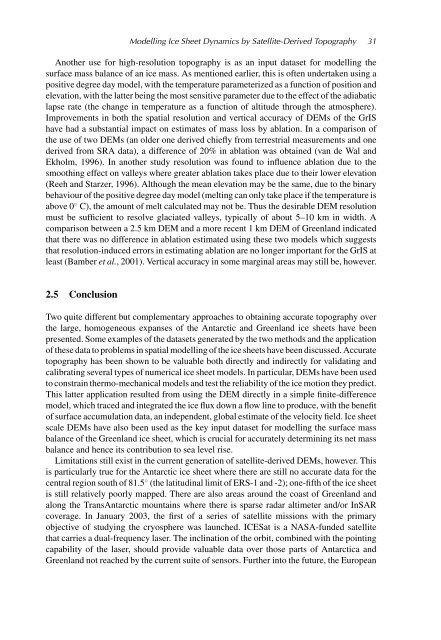1 Spatial Modelling of the Terrestrial Environment - Georeferencial
1 Spatial Modelling of the Terrestrial Environment - Georeferencial
1 Spatial Modelling of the Terrestrial Environment - Georeferencial
Create successful ePaper yourself
Turn your PDF publications into a flip-book with our unique Google optimized e-Paper software.
<strong>Modelling</strong> Ice Sheet Dynamics by Satellite-Derived Topography 31<br />
Ano<strong>the</strong>r use for high-resolution topography is as an input dataset for modelling <strong>the</strong><br />
surface mass balance <strong>of</strong> an ice mass. As mentioned earlier, this is <strong>of</strong>ten undertaken using a<br />
positive degree day model, with <strong>the</strong> temperature parameterized as a function <strong>of</strong> position and<br />
elevation, with <strong>the</strong> latter being <strong>the</strong> most sensitive parameter due to <strong>the</strong> effect <strong>of</strong> <strong>the</strong> adiabatic<br />
lapse rate (<strong>the</strong> change in temperature as a function <strong>of</strong> altitude through <strong>the</strong> atmosphere).<br />
Improvements in both <strong>the</strong> spatial resolution and vertical accuracy <strong>of</strong> DEMs <strong>of</strong> <strong>the</strong> GrIS<br />
have had a substantial impact on estimates <strong>of</strong> mass loss by ablation. In a comparison <strong>of</strong><br />
<strong>the</strong> use <strong>of</strong> two DEMs (an older one derived chiefly from terrestrial measurements and one<br />
derived from SRA data), a difference <strong>of</strong> 20% in ablation was obtained (van de Wal and<br />
Ekholm, 1996). In ano<strong>the</strong>r study resolution was found to influence ablation due to <strong>the</strong><br />
smoothing effect on valleys where greater ablation takes place due to <strong>the</strong>ir lower elevation<br />
(Reeh and Starzer, 1996). Although <strong>the</strong> mean elevation may be <strong>the</strong> same, due to <strong>the</strong> binary<br />
behaviour <strong>of</strong> <strong>the</strong> positive degree day model (melting can only take place if <strong>the</strong> temperature is<br />
above 0 ◦ C), <strong>the</strong> amount <strong>of</strong> melt calculated may not be. Thus <strong>the</strong> desirable DEM resolution<br />
must be sufficient to resolve glaciated valleys, typically <strong>of</strong> about 5–10 km in width. A<br />
comparison between a 2.5 km DEM and a more recent 1 km DEM <strong>of</strong> Greenland indicated<br />
that <strong>the</strong>re was no difference in ablation estimated using <strong>the</strong>se two models which suggests<br />
that resolution-induced errors in estimating ablation are no longer important for <strong>the</strong> GrIS at<br />
least (Bamber et al., 2001). Vertical accuracy in some marginal areas may still be, however.<br />
2.5 Conclusion<br />
Two quite different but complementary approaches to obtaining accurate topography over<br />
<strong>the</strong> large, homogeneous expanses <strong>of</strong> <strong>the</strong> Antarctic and Greenland ice sheets have been<br />
presented. Some examples <strong>of</strong> <strong>the</strong> datasets generated by <strong>the</strong> two methods and <strong>the</strong> application<br />
<strong>of</strong> <strong>the</strong>se data to problems in spatial modelling <strong>of</strong> <strong>the</strong> ice sheets have been discussed. Accurate<br />
topography has been shown to be valuable both directly and indirectly for validating and<br />
calibrating several types <strong>of</strong> numerical ice sheet models. In particular, DEMs have been used<br />
to constrain <strong>the</strong>rmo-mechanical models and test <strong>the</strong> reliability <strong>of</strong> <strong>the</strong> ice motion <strong>the</strong>y predict.<br />
This latter application resulted from using <strong>the</strong> DEM directly in a simple finite-difference<br />
model, which traced and integrated <strong>the</strong> ice flux down a flow line to produce, with <strong>the</strong> benefit<br />
<strong>of</strong> surface accumulation data, an independent, global estimate <strong>of</strong> <strong>the</strong> velocity field. Ice sheet<br />
scale DEMs have also been used as <strong>the</strong> key input dataset for modelling <strong>the</strong> surface mass<br />
balance <strong>of</strong> <strong>the</strong> Greenland ice sheet, which is crucial for accurately determining its net mass<br />
balance and hence its contribution to sea level rise.<br />
Limitations still exist in <strong>the</strong> current generation <strong>of</strong> satellite-derived DEMs, however. This<br />
is particularly true for <strong>the</strong> Antarctic ice sheet where <strong>the</strong>re are still no accurate data for <strong>the</strong><br />
central region south <strong>of</strong> 81.5 ◦ (<strong>the</strong> latitudinal limit <strong>of</strong> ERS-1 and -2); one-fifth <strong>of</strong> <strong>the</strong> ice sheet<br />
is still relatively poorly mapped. There are also areas around <strong>the</strong> coast <strong>of</strong> Greenland and<br />
along <strong>the</strong> TransAntarctic mountains where <strong>the</strong>re is sparse radar altimeter and/or InSAR<br />
coverage. In January 2003, <strong>the</strong> first <strong>of</strong> a series <strong>of</strong> satellite missions with <strong>the</strong> primary<br />
objective <strong>of</strong> studying <strong>the</strong> cryosphere was launched. ICESat is a NASA-funded satellite<br />
that carries a dual-frequency laser. The inclination <strong>of</strong> <strong>the</strong> orbit, combined with <strong>the</strong> pointing<br />
capability <strong>of</strong> <strong>the</strong> laser, should provide valuable data over those parts <strong>of</strong> Antarctica and<br />
Greenland not reached by <strong>the</strong> current suite <strong>of</strong> sensors. Fur<strong>the</strong>r into <strong>the</strong> future, <strong>the</strong> European

















